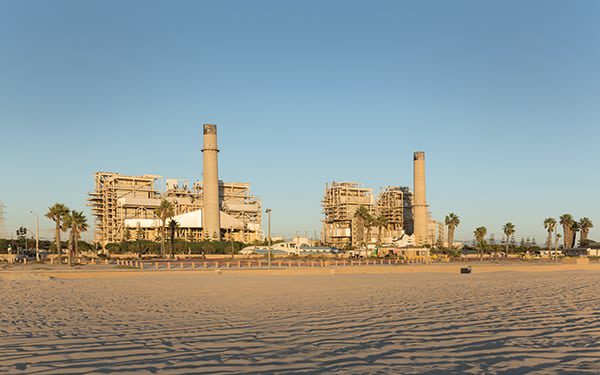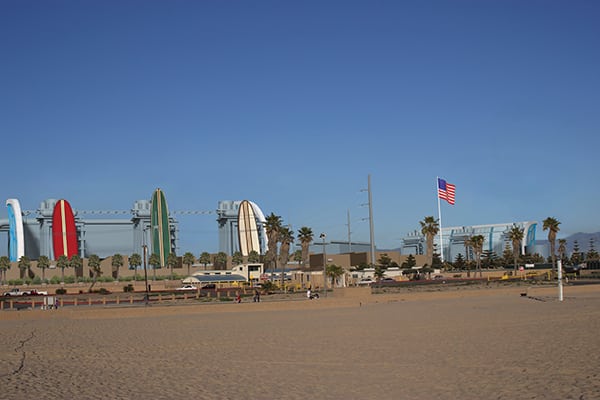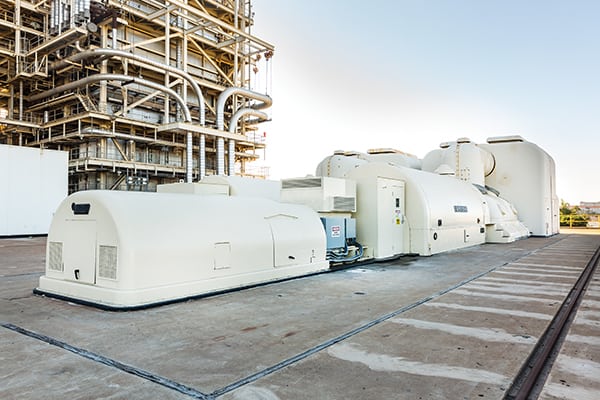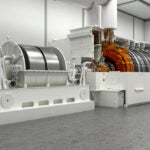Faced with a critical shortfall in voltage support after the loss of the San Onofre nuclear plant, the California Independent System Operator called on AES to convert two retired units at its Huntington Beach station to synchronous condensers. The experience offers lessons for other regions looking to deal with impending plant retirements and changing grids.
The future is looking bright for AES Huntington Beach Power Generating Station. Renderings of a proposed new look for the power plant—located steps from the beach on the Pacific Coast Highway—include massive surfboards and waves masking six new 120-foot structures slated to replace two 210-foot stacks (Figure 1). The facelift is part of a greater modernization initiative to create a cleaner, more efficient natural gas power plant. But the real innovation coloring the future of the plant and its surrounding electrical grid is happening below the surface.
A recent conversion from generators to synchronous condensers has the plant not only stabilizing the grid and keeping the lights on in times of high demand, but also keeping the air just a little bit cleaner in the process.
Keeping the Lights On
The California Public Utilities Commission (CPUC) requires its utilities to plan for a 15% Planning Reserve Margin of excess generation. In peak seasons like Southern California’s sweltering summers, additional voltage support is often required to maintain this balance and stabilize the grid. Historically, Southern California has had adequate reserve margins, but in 2012 when the San Onofre Nuclear Generating Station (SONGS)—the largest plant in Southern California—was shut down, this level of comfort quickly changed.
The loss of SONGS during the summer of 2012 left Southern California with a 2,200-MW hole in its grid. Without SONGS, generation from other nearby power plants was insufficient to meet electricity demand, and importing that much replacement power into the area would put too much stress on the region’s grid. To fill this gap, Huntington Beach’s steam turbine Units 3 and 4 were temporarily brought back from a nearly two-year retirement. But these units could not stay on indefinitely because of an emissions transaction with Edison Mission Energy (EME) that had been completed earlier. The terms of the agreement required AES to retire the Unit 3 and 4 boilers and related equipment to enable EME’s new combined cycle project to begin commercial operations.
When it became clear in late 2012 that an alternative means of voltage support was necessary due to the potential retirement of SONGS, the California Independent System Operator (CAISO) approached the team at AES and suggested the switch from generators to synchronous condensers. Before this point, AES Huntington Beach was primarily run via generators, and the team had little experience with synchronous condensers, but the solution was undoubtedly a viable one, so the team got to work.
Many stakeholders were involved in the project, including Southern California Edison, the California Energy Commission (CEC), the CPUC, San Diego Gas & Electric, and even the rate-paying citizens of Orange County. With such an invested audience of stakeholders, AES began procuring a wide range of solution options that could meet the stringent regulatory, budgetary, and deadline demands.
Assessing the Technology
There are a number of different ways to provide voltage support to a transmission grid. Though generation provides support, reactive power is needed to move the power across the grid to serve load.
Static var compensators (SVCs) are a popular method for reactive power compensation to improve and balance a network. An SVC is made up of capacitive and inductive components that inject reactive power and deliver dynamic performance during periods of high demand. However, SVCs may have limited absorption levels and fault current performance.
Synchronous condensers, like SVCs, are another means of power compensation, but unlike SVCs, synchronous condensers are single-component rotating machines—also known as flywheels—which positively or negatively alter the field of the generator to distribute or absorb reactive power. The single component design allows for smooth waveform and a quicker, more reliable start-stop in a way that does not negatively affect the system load. Synchronous condensers also have a higher capacity to handle fault currents, making them ideal in applications such as this one.
Facing Challenges
Unfortunately, AES’s generators presented three challenges for conversion to synchronous condensers:
- Multiple Original Equipment Manufacturers. The plant consists of two different brands of generators, General Electric and Westinghouse, in a cross-compound system. Finding a conversion solution that would work equally well for both generators was necessary. This type of situation would normally require all new equipment to be installed for the conversion, which would have inflated both the timeline and budget for the project.
- Size. Though the generators at AES aren’t abnormally sized compared to plants of this capacity, they are still physically large. A conversion solution for equipment this size generally requires substantial electrical modification to assist in controlling the unit’s speed and a significant amount of system analysis and adjustment.
- Age. As an added complication, the turbines at AES were nearly 50 years old, so the issue of potential replacement or repair of the existing equipment was a concern. Most modern generators are converted to motors to turn themselves on and bring themselves up to speed, serving dual electrical purpose. The generators at AES were not designed for that type of functionality.
With each of these challenges came added stress in identifying a solution that could be completed on time and within the allotted budget.
The team at AES partnered with Siemens Energy to review their options. With the tight timeline being the most critical factor, a moment of clarity brought a solution that took repair or replacement of the AES turbines out of the equation. After nearly a month of comprehensive evaluation, the team was able to retain most of AES’s existing infrastructure without requiring new equipment or significant upgrades. The only new equipment investments made were those pieces that immediately supported the conversion: pony motors, thrust bearings, variable frequency drives (VFDs), and new distributed control system (DCS) panels.
“Timing was a critical issue,” said Phil Pettingill, director of regulatory strategy at CAISO. “There was a constant stream of questions from regulators and policymakers regarding cost and schedule. Both AES and Siemens were very effective at coming back to us and telling us exactly what we needed and how they could meet the evolving timeline.”
Maintaining a Balance
The innovation behind the customized approach was an easy sell to the stakeholders. AES, the CEC, the South Coast Air Quality Management District (SCAQMD), and CAISO all quickly realized that the proposed approach was the only one that could fulfill all of the stringent requirements of the project, particularly the looming summer deadline. The application was filed with the CEC on Oct. 5, 2012, and the synchronous condensers needed to be fully functional no later than June 28, 2013.
Work began immediately after project approvals were granted in late 2012. AES employed Siemens to lead a team of contractors in the installation. With the tight timeline constantly in mind, the Siemens team made the decision to adapt to the situation and materials at hand, rather than bring in a slew of new equipment.
The Huntington Beach plant operated as a cross-compound system. There were four generators onsite, but only two acceleration models were needed to bring the system to life. Essentially, the two small pony motors were used as prime movers, which replaced the existing boilers and steam turbines. Original plans called for one power source to control the motors, but after careful consideration, the team decided to install a second source to provide a redundant source of power should any unforeseen circumstances affect drive functionality. The VFDs were installed to drive the strategically located pony motors (Figure 2) and keep the motors’ size, horsepower, and costs down thanks to the way the units were configured with the two tandem generators. The drives allow the generators to be brought up slowly and simultaneously while keeping them in an electrical lock. Though adding the additional power source was not part of the original plan and required additional time to implement, the team had been prepared by building a buffer into the schedule for minor delays.
Along the way, the team faced additional challenges that could have potentially affected the timeline. At one point in the installation, an overhead crane failed. Ultimately, the crane was repaired and the project stayed on track.
Despite a few minor setbacks, the converted system was successfully started up on June 28, 2013—the exact date that the project was slated for completion—and has been a reliable resource ever since.
The generators can be automatically excited when needed and as a result do not need to work nearly as hard as they had in the past. As an added bonus, synchronous condensers require under an hour of start-up time, as opposed to nearly the 12 hours required to fire a boiler, so they can be tapped on demand in times of need.
“We needed a project that could provide the reactive support needed to optimize power transfers across L.A. and into the San Diego region,” said Pettingill. “After the summer of 2013, we can definitively say those needs were met with the synchronous condenser project at AES Huntington Beach.”
Clearing the Air
When the synchronous condenser conversion was presented, the SCAQMD appreciated the fact that it translated into a nongenerating resource that provides voltage support without any emissions. Emissions are a growing concern with industrial and power plants around the world, particularly in California. State legislation requires any investments in generation resources (new construction and renovation) that provide electricity to California residents to meet a specific emissions standard of 1,100 lb CO2/MWh or less. By providing reactive power to transfer energy across grids, the synchronous condensers help eliminate the need for constant generator operation and reduce those emissions.
Appealing to the Masses
Synchronous condensers can provide dynamic benefits across multiple platforms and applications. In AES’s case, they assist in distributing reactive power to the grid as necessary in times of peak usage, but they can also absorb reactive power when necessary.
Though AES is looking toward modernizing the plant, both inside and out, with more efficient infrastructure and a beach-themed wave and surfboard exterior, the trend to convert to synchronous condensers has applications well beyond Southern California:
- Renewable energy. In California as in many other regions, higher levels of renewables are being added to the system. As a result, introducing additional reactive power sources such as synchronous condensers can help deal with challenges of transforming the grid in order to accommodate potential differences in power sources.
- Voltage sags. Conversely, as more coal-fired plants are retired, more inertia is lost, creating voltage sags across the country. Synchronous condensers have the capability, with on-demand excitation and acceleration, to provide dynamic voltage support to make up for that loss.
- Long distance and highly concentrated grids. For electric suppliers whose grids span great distances, synchronous condensers come in particularly handy. The synchronous condensers move reactive power and change the voltage of the grid to balance the distribution across greater distances or to a greater number of consumers.
- Large industrial loads. In high-activity industrial settings such as paper mills, steel mills, manufacturing facilities, and more, system stability is constantly evolving. Loads need reactive power to assist with initialization and stabilization. The synchronous condensers are a low-risk means of consuming and dissipating reactive power as needed, providing an array of benefits and avoiding outage situations altogether. For industrial plants with a variety of inductive loads such as motors, drives, and transformers, synchronous condensers provide reactive power to get things up and running quickly and smoothly.
Drawing Conclusions
The summer of 2013 in southern Orange and San Diego counties went smoothly. Even without the 2,200 MW of generation from SONGS, residents of Southern California stayed cool and calm with their lights and air conditioners on.
“The effort by the whole team to restart the units before the summer of 2012 with a herculean effort and under a short time frame was nothing short of amazing,” CAISO president and CEO Steve Berberich said. “To follow that up with a sprint to convert those same units to synchronous condensers cemented the immense respect and confidence we have in the AES Huntington Beach team.”
As for the future of the synchronous condensers at AES, their story doesn’t end here. A Reliability Must-Run contract exists between CAISO and AES. Current contract provisions call for the retirement of one of the synchronous condensers at the end of 2016 and the other at the end of 2017 in order for AES to undertake its once-through cooling compliance repowering plans for the entire facility. However, CAISO will annually assess whether or not the grid has a reliability need that can still be met by this project. The evaluation of this option will need to consider how an extension of the synchronous condenser’s operation beyond 2017 would affect the long-term repowering plans for the AES Huntington Beach facility. There has also been discussion of converting one or both of the retired generators at SONGS to synchronous condensers by the summer of 2015.
There is plenty of opportunity to replicate the success realized by the AES conversion project across the country. The job of a plant manager in every industry is to evaluate and manage risk while also maximizing the return on the asset. Synchronous condenser conversion is a very low-risk approach. Every grid operator or transmission planning entity has unique needs. It is important to consider how certain technologies like synchronous condensers can help to optimize power flow, minimize risk, and maximize benefits to help meet the needs at hand. ■
— Chris Davidson is the electrical solutions business development director at Siemens Energy IC&E. Weikko Wirta is the Southland operations and maintenance manager, site leader, and former plant manager at AES Huntington Beach.













